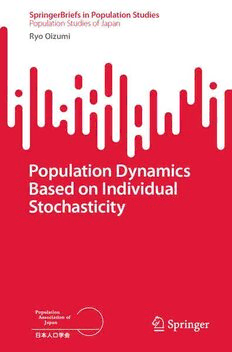
Population Dynamics Based on Individual Stochasticity PDF
Preview Population Dynamics Based on Individual Stochasticity
SpringerBriefs in Population Studies Population Studies of Japan Ryo Oizumi Population Dynamics Based on Individual Stochasticity SpringerBriefs in Population Studies Population Studies of Japan Editor-in-Chief ToshihikoHara,ProfessorEmeritus,SapporoCityUniversity,Sapporo,Hokkaido, Japan SeriesEditors ShinjiAnzo,Tokyo,Japan HisakazuKato,Tokyo,Japan NorikoTsuya,Tokyo,Japan ToruSuzuki,Chiba,Japan KoheiWada,Tokyo,Japan HisashiInaba,Tokyo,Japan MinatoNakazawa,Kobe,Japan JimRaymo,NewJersey,USA RyuichiKaneko,Tokyo,Japan SatomiKurosu,Chiba,Japan ReikoHayashi,Tokyo,Japan HiroshiKojima,Tokyo,Japan TakashiInoue,Tokyo,Japan The world population is expected to expand by 39.4% to 9.6 billion in 2060 (UN World Population Prospects, revised 2010). Meanwhile, Japan is expected to see its population contract by nearly one third to 86.7 million, and its proportion of theelderly(65yearsofageandover)willaccountfornolessthan39.9%(National InstituteofPopulationandSocialSecurityResearchinJapan,PopulationProjections forJapan2012).Japanhasenteredthepost-demographictransitionalphaseandwill bethefastest-shrinkingcountryintheworld,followedbyformerEasternblocnations, leadingotherAsiancountriesthatareexperiencingdrasticchanges. Adecliningpopulationthatisrapidlyagingimpactsacountry’seconomicgrowth, labormarket,pensions,taxation,healthcare,andhousing.Thesocialstructureand geographical distribution in the country will drastically change, and short-term as wellaslong-termsolutionsforeconomicandsocialconsequencesofthistrendwill berequired. This series aims to draw attention to Japan’s entering the post-demographic transitionphaseandtopresentcutting-edgeresearchinJapanesepopulationstudies. ItwillincludecompactmonographsundertheeditorialsupervisionofthePopulation AssociationofJapan(PAJ). ThePAJwasestablishedin1948andorganizesresearcherswithawiderangeof interestsinpopulationstudiesofJapan.Themajorfieldsare(1)populationstructure andaging;(2)migration,urbanization,anddistribution;(3)fertility;(4)mortalityand morbidity;(5)nuptiality,family,andhouseholds;(6)laborforceandunemployment; (7)populationprojectionandpopulationpolicy(includingfamilyplanning);and(8) historicaldemography.Since1978,thePAJhasbeenpublishingtheacademicjournal JinkogakuKenkyu(TheJournalofPopulationStudies),inwhichmostofthearticles arewritteninJapanese. Thus,thescopeofthisseriesspanstheentirefieldofpopulationissuesinJapan, impactsonsocioeconomicchange,andimplicationsforpolicymeasures.Itincludes population aging, fertility and family formation, household structures, population health,mortality,humangeographyandregionalpopulation,andcomparativestudies withothercountries. This series will be of great interest to a wide range of researchers in other countriesconfrontingapost-demographictransitionstage,demographers,population geographers, sociologists, economists, political scientists, health researchers, and practitionersacrossabroadspectrumofsocialsciences. Ryo Oizumi Population Dynamics Based on Individual Stochasticity RyoOizumi NationalInstituteofPopulationandSocial SecurityResearch Tokyo,Japan ISSN 2211-3215 ISSN 2211-3223 (electronic) SpringerBriefsinPopulationStudies ISSN 2198-2724 ISSN 2198-2732 (electronic) PopulationStudiesofJapan ISBN 978-981-19-3547-3 ISBN 978-981-19-3548-0 (eBook) https://doi.org/10.1007/978-981-19-3548-0 ©TheAuthor(s),underexclusivelicensetoSpringerNatureSingaporePteLtd.2022 Thisworkissubjecttocopyright.AllrightsarereservedbythePublisher,whetherthewholeorpartof thematerialisconcerned,specificallytherightsoftranslation,reprinting,reuseofillustrations,recitation, broadcasting,reproductiononmicrofilmsorinanyotherphysicalway,andtransmissionorinformation storageandretrieval,electronicadaptation,computersoftware,orbysimilarordissimilarmethodology nowknownorhereafterdeveloped. Theuseofgeneraldescriptivenames,registerednames,trademarks,servicemarks,etc.inthispublication doesnotimply,evenintheabsenceofaspecificstatement,thatsuchnamesareexemptfromtherelevant protectivelawsandregulationsandthereforefreeforgeneraluse. Thepublisher,theauthors,andtheeditorsaresafetoassumethattheadviceandinformationinthisbook arebelievedtobetrueandaccurateatthedateofpublication.Neitherthepublishernortheauthorsor theeditorsgiveawarranty,expressedorimplied,withrespecttothematerialcontainedhereinorforany errorsoromissionsthatmayhavebeenmade.Thepublisherremainsneutralwithregardtojurisdictional claimsinpublishedmapsandinstitutionalaffiliations. ThisSpringerimprintispublishedbytheregisteredcompanySpringerNatureSingaporePteLtd. The registered company address is: 152 Beach Road, #21-01/04 Gateway East, Singapore 189721, Singapore Preface Atpresent,diversityisoneofthemostimportantissuesworldwide.Diversityinrace, gender,politicalideology,andculturehascreatedconflictanddivisionthroughout history.Tolerancefordiversityisnowregardedasthebasisforstabilizingsociety. Diversity does not only explain the complex political or cultural components of human society: since 2020, the symptoms of COVID-19, a global pandemic, have alsoexhibiteddiversity.SomeCOVIDpatientsmaybeasymptomatic,whereasothers may become severely ill and die. These individual differences can be regarded as a form of diversity. We have long known that such individual differences are the drivingforcesintheevolutionoforganisms.Biologistshaveassertedthatdiversity within a population is necessary for adapting to environmental changes and infec- tiousdiseases.Byreferringtodiversityasindividualstochasticity,thisbookaimsto incorporateitintomathematicaldemographicmodels.Theauthorbelievesthatthe readersofthisbookwillfinditusefultobroadentheirperspectiveondemography. Tokyo,Japan RyoOizumi v Introduction: Stochasticity in Demography Sincetheendofthenineteenthcenturyandtheonsetofthetwentiethcentury,scien- tificdevelopmentshaveprovideduswithrevolutionaryprospectsforunderstanding theuniverse.Therearethreedifferentanalyticalscales,namelymacroscopic,micro- scopic, and mesoscopic, e.g., the theory of relativity, quantum theory, and chaos theory,respectively.Asarepresentativemacroscopicconcept,thegeneraltheoryof relativityexplainsproblemsontheuniversalscale.Ithaschangedthelandscapefor timeandspace;botharenotabsolutebutchangewiththephysicalenvironmentof the observer. As a representative microscopic concept, quantum theory describes thedynamicsofelementaryparticles.Thistheorypostulatesthatthelawofnature incorporatesprobability,whichwasdifficultforpeopletoacceptatthetimeitwas proposed. The mesoscopic scale is an ordinary scale that is observed in daily life. Chaostheory,statisticalphysics,fluidmechanics,anddemographyarecategorized underthisscale.Inparticular,chaostheoryshowsthatuncertaintyoccursindeter- ministicsystems,andthisideawasalsounacceptablepreviously.Amongthethree aforementionedscales,themesoscopicscaleisthemostcomplicatedonebecauseit intermixes withboth of theother twoscales.Moreover, itincludes not only deter- ministic systems, but also stochastic systems, such as the variable environment. Therefore,systemsonthisscaleareoftencalledcomplexsystems. These topics are thought to be involved only in physical phenomena and not in demography. However, the complicated activities and population dynamics of humans occur on the mesoscopic scale, where the three aforementioned concepts intersect. Each behavior, as a form of microscopic dynamics, yields macroscopic populationdynamicsasphysicalphenomena.Thus,demographycanalsoberegarded asafieldofphysics. Forexample,internalordomesticmigrationoccursforvariousreasons,suchas jobtransfer,schoolattendance,andmarriage.Althoughtheseeventsarenotrandom, weevaluatethemusingstatisticsinsteadofidentifyingtheircauses.Thisapproach has the same context as statistical physics. Each classical particle follows Newto- nian mechanics; however, the heat bath dynamics obey statistics such that each particlebehavesrandomly.Meanwhile,humanbeingsandotherspecieshaveindi- vidual differences that may have a stochastic effect on their population dynamics. vii viii Introduction:StochasticityinDemography Forexample,individualswithahealthyimmunesystemsurvivedtheGreatPlague and other epidemics. We know that such events often occurred in human history. The heterogeneity of individuals brings innovation to human society, protects the population from extinction, and promotes evolution. Interpreting heterogeneity as individualstochasticitycanprovideanewperspectiveondemography. Thisbookaimstoreconstructmathematicaldemographyonthebasisofindividual stochasticity. To this end, we use our knowledge of stochastic analysis. However, this is not a mathematical treatise; the mathematical justification is limited to the minimum required to be applied to this field. There are many excellent mathe- matical works on stochastic analysis, and the mathematical details are presented therein.Becauseourtheoryfocusesonthedescriptionofbiologicalanddemographic phenomena, we often use techniques that are not always justified mathematically. Abstractmathematicaltheoryisusefulforexplainingawiderangeofdemographic andbiologicalevents.Meanwhile,forthebenefitofreaderswhoareunfamiliarwith suchmathematicalconcepts,examplesthatareanalyticallysolvableareprovidedin eachchapter.Althoughtheyarenotnecessarilyforhumansubjects,theywillenable thereadertounderstandthetheorydevelopedinthisbook.Finally,weexpectthis booktoenablereaderstobroadentheirperspectiveonpopulationdynamics. Tokyo,Japan RyoOizumi [email protected] Contents 1 DeterministicandStochasticPopulationModels ................... 1 1.1 MalthusEquationandStochasticMalthusEquations .............. 1 1.2 BasicPropertiesforSDEModels .............................. 4 1.3 SDEsandPartialDifferentialEquations ........................ 7 References ...................................................... 12 2 LinearStructuredPopulationBasedonSDE ....................... 13 2.1 Age-StructuredPopulationModelwithIndividualStochasticity .... 14 2.2 PathIntegralRepresentationandClassicalLifeSchedule .......... 17 2.2.1 PathIntegralRepresentationandAnalyticalMechanics inDemography ....................................... 17 2.2.2 LagrangianandHamiltonianExpressionsinPathIntegral ... 21 2.3 CharacteristicFunctionandEigenfunctions ..................... 24 2.3.1 CharacteristicFunction andAsymptoticPopulation Behavior ............................................. 25 2.3.2 EigenfunctionsandFeynman–KacFormula ............... 27 2.4 DemographicIndicators ...................................... 32 2.5 ApplicationtoaSemelparityModel ............................ 34 References ...................................................... 46 3 Non-linearStructuredPopulationModels ......................... 49 3.1 r/KSelectionTheory ......................................... 49 3.2 Non-linearMulti-statePopulationModel ....................... 51 3.3 StabilityofStationaryPopulation .............................. 52 3.3.1 StationaryPopulation .................................. 52 3.3.2 CharacteristicEquationforLocalStability ................ 54 3.4 ConcreteExample ........................................... 57 3.4.1 ResourceAcquisitionCompetitionModelandStationary Population ........................................... 57 3.4.2 LocalStabilityofStationaryPopulationinSemelparous Species .............................................. 59 References ...................................................... 63 ix x Contents 4 LifeHistoryEvolutionandAdaptiveStochasticControls ............ 65 4.1 BasicTheoremforAdaptiveLifeHistory ....................... 65 4.2 OptimalStoppingProbleminLifeHistories ..................... 68 4.3 AdaptiveReproductiveTimingforSemelparousSpecies .......... 71 4.4 OptimalLifeScheduleProblemandHamilton–Jacobi–Bellman Equation ................................................... 72 4.4.1 StationaryControl .................................... 75 4.5 Reconsiderationofr/KSelectionTheory ........................ 77 4.5.1 Adaptive Resource Utilization Model in Optimal ForagingProblem ..................................... 77 4.5.2 ComplicatedRelationshipamongDemographicIndices undertheDensityEffect ............................... 80 4.5.3 Summary ............................................ 84 References ...................................................... 84 5 ApplicationtoExternalStochasticity .............................. 87 5.1 ExternalStochasticityandPerturbationMethod .................. 87 References ...................................................... 97 Epilogue:PopulationDynamicsfromthePerspectiveofIndividual Stochasticity ....................................................... 99
